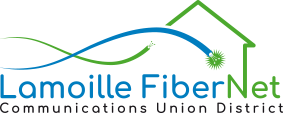Quick facts about Vermont Communications Union Districts
May 10, 2021 ‒ Vermont Communications Union Districts Association (VCUDA) represents the interests of Vermont’s nine CUDs, regional municipalities created to bring world-class broadband to all on-grid premises in their districts. At the end of this article, see the quick facts about Vermont Communications Union Districts.
The American Recovery Plan Act (ARPA) presents a once-in-a-generation opportunity to expand broadband in Vermont — that must not be missed. VCUDA is urging approval of the Senate Finance Committee’s version of H360, and it sees the legislation as “setting the stage for Vermont to finally find its own way forward on broadband after two decades of watching private providers fail to meet the universal needs of the state’s residents.”
In 2019, the Governor and Legislature adopted CUDs as the strategy for solving Vermont’s broadband crisis (Vermont’s low population and difficult topography make it unattractive to for-profit providers).
Vermont’s first CUD, ECFiber, has brought broadband to almost every hill and valley of its rural territory. The 10 years it took can be cut in half for other CUDs with the help of this federal ARPA funding. The funds can also lower the debt needed to build networks, keeping service more affordable. Once networks are built, planning for subsidizing service for economically challenged households will be next.
CUDs are focused on building fiber-based internet capable of at least 100/100 Mbps (for many in the federal government, 100/100 is the new benchmark – current one is 25/3). If CUDs are provided resources for this goal, Vermont will go from having pockets of true broadband for a quarter of the state to world-class statewide coverage from reliable, community-based providers.
Vermont Communications Union Districts (CUDs) Are:
- Governmental units, like waste or water districts, made up of towns and unincorporated areas, representing 187 or 73% of Vermont’s towns, and growing.Created in 2015 by state statute to provide universal access to high-speed broadband within their territories.
- Not allowed to tax property but are permitted to issue municipal revenue bonds.
- Nine CUDs operate across the state – CV Fiber (Central Vermont); DV Fiber (Deerfield Valley); EC Fiber (East Center/Upper Valley); Lamoille FiberNet CUD; Maple Broadband (Addison); Otter Creek CUD (Rutland); NEK Broadband (Northeast Kingdom); Northwest CUD (Franklin/Grand Isle).
- About 400 volunteers, active in CUD governance statewide.
- A municipality joins a CUD by an affirmative vote of its governing body and appointing one or more local representatives.
Vermont Put CUDs at the Center of Its Strategy Because:
- The broadband industry is not regulated as a utility; it has been profit-driven, leaving over 60,000 VT locations — almost 20% of the state — without access to federally defined 25/3 Mbps broadband. 100/100 Mbps is not available to over 75% of Vermont.
- Vermont’s low population and difficult topography make its market unattractive to private providers. Vermont needed to find its own way; CUDs are the instruments to accomplish the task.
- With 2019’s Act 79, Vermont’s legislature and Gov. Scott incentivized formation of CUDs, following ECFiber’s model. The strategy prioritizes reaching underserved areas first, largely with grants and borrowed money, at no risk to local taxpayers.
What About Vermont Towns that Are Not in CUDs?
- Only 68 municipalities are not yet in CUDs.
- Many non-CUD members have largely achieved universal high-speed broadband. Almost half (30 towns) have fewer than 45 addresses without access to minimal high-speed broadband, often less than 1% of total addresses in the town or city.
- 50 towns not officially in CUDs have been included in CUD fiber network plans.
- The other 18 towns circle Chittenden County’s core, with about 2500 underserved addresses. Those towns/addresses deserve a solution, and the current bills include several options.
What about Affordability? VCUDA Believes:
- Making sure households can afford the world-class high-speed internet is an essential component of providing universal access and of CUD business planning.
- Establishing funding mechanisms for subsidies to qualifying households is important.
- Equal Access to Broadband, Inc., a 501c3, is actively developing a system for providing subsidies within the CUD framework.
- Requiring CUDs or others to commit to specifically priced plans will hamper their ability to provide universal access to high-speed broadband — it will make it more difficult to access the municipal revenue bond market i.e., where the balance of the money for building the statewide CUD systems will come from, absent additional federal grants.
VCUDA Wants a Future Vermont In Which:
- Every on-grid location has access to reliable, affordable high-speed internet service by 2027.
- All houses have the same ability to move data on the internet that citizens in the newest buildings of the biggest cities have, making the state an economic powerhouse in a world of remote work.
The mission of Lamoille FiberNet Communications Union District (LFCUD) is to make locally controlled, affordable and reliable high-speed internet service available to every address in our member towns – Belvidere, Cambridge, Eden, Hyde Park, Johnson, Morristown, Stowe, and Waterville. For more info, go to http://www.LamoilleFiber.net.





